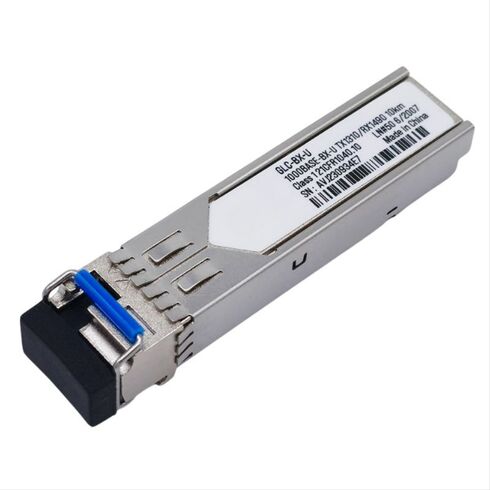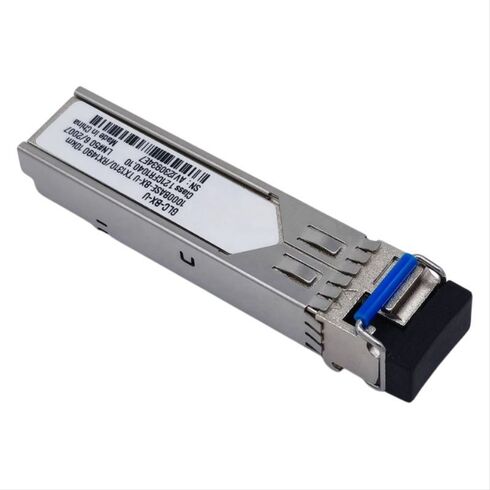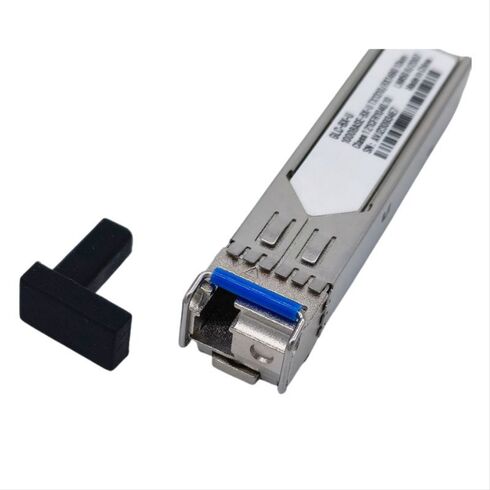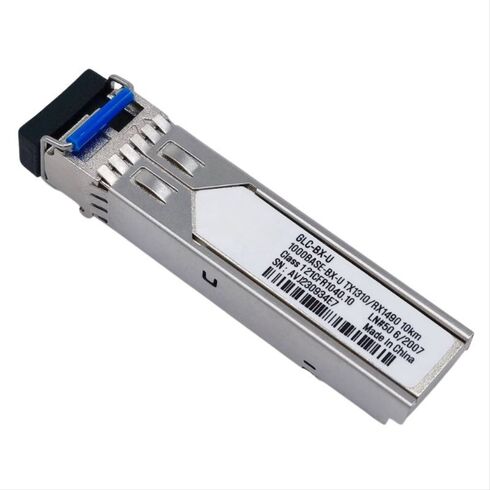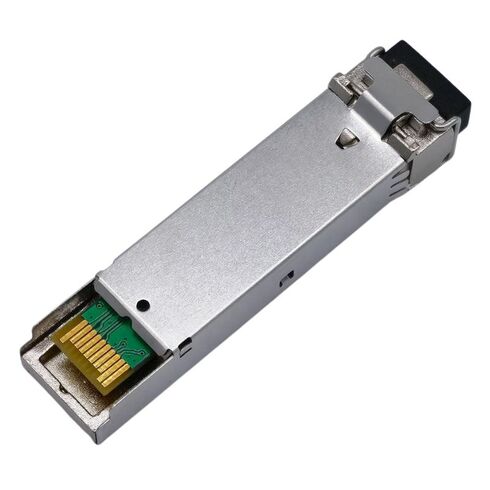GLC-BX-U= Cisco 1000base-bx10-u Upstream Bidirectional Transceiver
Brief Overview of GLC-BX-U=
Cisco GLC-BX-U= 1000base-bx10-u Upstream Bidirectional Single Fiber Transceiver Module With Digital Optical Monitoring (dom) Functions. Factory-Sealed New in Original Box (FSB) with 1 year replacement warranty
- — Free Ground Shipping
- — Min. 6-month Replacement Warranty
- — Genuine/Authentic Products
- — Easy Return and Exchange
- — Different Payment Methods
- — Best Price
- — We Guarantee Price Matching
- — Tax-Exempt Facilities
- — 24/7 Live Chat, Phone Support
- — Visa, MasterCard, Discover, and Amex
- — JCB, Diners Club, UnionPay
- — PayPal, ACH/Bank Transfer (11% Off)
- — Apple Pay, Amazon Pay, Google Pay
- — Buy Now, Pay Later - Affirm, Afterpay
- — GOV/EDU/Institutions PO's Accepted
- — Invoices
- — Deliver Anywhere
- — Express Delivery in the USA and Worldwide
- — Ship to -APO -FPO
- — For USA - Free Ground Shipping
- — Worldwide - from $30
Same product also available in:
| SKU/MPN | Warranty | Price | Condition | You save |
|---|---|---|---|---|
| GLC-BX-U= | 1 Year Warranty | $123.00 | Excellent Refurbished | You save: $43.05 (26%) |
| GLC-BX-U= | 1 Year Warranty | $142.00 | Factory-Sealed New Retail in Original Box (FSB) | You save: $49.70 (26%) |
Cisco GLC-BX-U= 1000BASE-BX10-U: A Comprehensive Overview
The Cisco GLC-BX-U= transceiver module is a high-performance, bidirectional single-fiber solution designed to enhance network efficiency and reliability. Featuring Digital Optical Monitoring (DOM) functions, this SFP transceiver ensures seamless integration with Gigabit Ethernet networks.
Key Features of the Cisco GLC-BX-U=
- Compact and versatile Small Form-factor Pluggable (SFP) design.
- Standards-compliant 1000BASE-BX10-U for dependable connectivity.
- 1.25 Gbit/sec data transfer rate for high-speed performance.
- Supports up to 10 km transmission distance on a single OS1 fiber strand.
- Transmit wavelength of 1310nm and receive wavelength of 1490nm.
- Equipped with an industry-standard LC connector for easy installation.
- Designed for single-mode fiber (SMF) environments.
Technical Specifications at a Glance
Performance and Compatibility
Engineered to support Gigabit Ethernet networks, the GLC-BX-U= achieves a line speed of 1.25 Gbit/sec, ensuring optimal data transmission. Its bidirectional single-fiber capability allows for cost-effective and efficient use of existing fiber infrastructure.
Optical and Connector Specifications
The transmitter operates at a wavelength of 1310nm, while the receiver functions at 1490nm, enabling smooth upstream and downstream communication. The LC connector ensures a secure and reliable connection with single-mode fiber (SMF).
Manufacturer and Part Details
This network device is manufactured by Cisco, a trusted name in networking solutions. The part number or SKU for this product is GLC-BX-U=, making it easy to identify and order for your specific needs.
Ideal for Diverse Network Environments
Designed to perform efficiently over distances of up to 10 kilometers, the Cisco GLC-BX-U= is suitable for enterprise networks, data centers, and telecommunications applications.
Why Choose the Cisco GLC-BX-U=?
- Reliable and durable network performance.
- Optimized for single-mode fiber setups.
- Compact design with easy plug-and-play installation.
- Meets industry standards for seamless compatibility.
Cisco GLC-BX-U= Transceiver Module Overview
The Cisco GLC-BX-U= 1000BASE-BX10-U is a highly efficient and reliable bidirectional single-fiber transceiver module. Designed to operate over single-mode fiber, this transceiver ensures seamless network integration and outstanding performance for enterprise and service provider networks. Featuring digital optical monitoring (DOM) functions, the module provides valuable diagnostic and operational information to optimize network efficiency.
Key Features of Cisco GLC-BX-U=
The Cisco GLC-BX-U= transceiver module comes packed with features that make it a critical component for modern networking environments. These features include:
- Support for bidirectional (BiDi) communication over a single strand of fiber.
- 1000BASE-BX10-U standard compliance for up to 10 kilometers of reach on single-mode fiber (SMF).
- Transmission wavelength of 1310 nm and reception wavelength of 1490 nm.
- Digital Optical Monitoring (DOM) for real-time monitoring of optical parameters.
- Hot-swappable design for easy deployment and replacement.
- Support for advanced Cisco networking protocols, ensuring seamless integration.
Bidirectional Single Fiber Communication
The GLC-BX-U= module uses bidirectional technology to transmit and receive data on a single strand of fiber. This unique approach reduces infrastructure costs and simplifies cable management. The bidirectional design makes it ideal for environments where fiber availability is limited or where space constraints necessitate efficient use of fiber strands.
Applications of Bidirectional Communication
Bidirectional transceivers are highly suitable for:
- Metropolitan area networks (MANs).
- Enterprise data centers with constrained fiber resources.
- Internet service provider (ISP) deployments needing efficient fiber utilization.
Advantages of Single-Fiber Technology
Utilizing a single fiber for both upstream and downstream communication provides numerous advantages:
- Reduced installation and maintenance costs.
- Minimized physical fiber footprint in network deployments.
- Enhanced scalability for expanding network requirements.
Digital Optical Monitoring (DOM) Functions
The inclusion of DOM functionality allows network administrators to monitor key parameters in real time, enhancing network reliability and performance. Parameters monitored by DOM include:
- Transmitter optical power.
- Receiver optical power.
- Laser bias current.
- Supply voltage.
- Operating temperature.
Benefits of DOM
By providing real-time data, DOM enables:
- Proactive troubleshooting and issue resolution.
- Optimized network performance through precise parameter adjustments.
- Extended equipment lifespan through informed maintenance practices.
Compatibility and Integration
The Cisco GLC-BX-U= transceiver is compatible with a wide range of Cisco networking equipment. Its hot-swappable design ensures seamless integration with existing network infrastructures, minimizing downtime during deployment or replacement.
Supported Cisco Platforms
This transceiver is supported on various Cisco platforms, including:
- Catalyst switches.
- ASR and ISR routers.
- NX-OS platforms for data centers.
Interoperability with Industry Standards
Beyond Cisco platforms, the GLC-BX-U= adheres to industry standards, ensuring compatibility with other networking devices that support the 1000BASE-BX10-U specification. This flexibility makes it a versatile choice for diverse network environments.
Performance Specifications
The GLC-BX-U= transceiver delivers robust performance, meeting the demands of high-speed and reliable communication. Key specifications include:
- Maximum data rate: 1 Gbps.
- Wavelengths: 1310 nm (transmit) and 1490 nm (receive).
- Maximum reach: 10 kilometers over single-mode fiber.
- Operating temperature range: -40°C to +85°C.
Reliability in Extreme Environments
The extended operating temperature range makes the GLC-BX-U= suitable for challenging environments, including outdoor deployments and industrial settings. Its rugged design ensures consistent performance under varying conditions.
Efficient Power Consumption
With low power consumption, the GLC-BX-U= minimizes operational costs and contributes to environmentally friendly networking solutions. This energy efficiency is critical for large-scale deployments where power budgets are a concern.
Use Cases for Cisco GLC-BX-U=
The GLC-BX-U= transceiver serves a wide range of applications, making it a versatile choice for network architects. Common use cases include:
Service Provider Networks
In service provider environments, the GLC-BX-U= enables efficient delivery of high-speed internet, voice, and video services. Its bidirectional design reduces fiber leasing costs and maximizes infrastructure utilization.
Enterprise Networks
For enterprises, the GLC-BX-U= facilitates seamless connectivity between campus buildings and remote offices. Its long reach and high reliability ensure uninterrupted communication across the organization.
Data Center Interconnects
The transceiver is ideal for connecting data centers, where high bandwidth and low latency are critical. Its support for single-mode fiber ensures scalability and future-proofing for growing data demands.
How to Choose the Right Transceiver
When selecting a transceiver module, several factors should be considered to ensure compatibility and performance:
Network Requirements
Evaluate your network's data rate, distance, and fiber type requirements. The GLC-BX-U= is optimized for 1 Gbps over single-mode fiber up to 10 kilometers.
Compatibility
Ensure the transceiver is compatible with your existing hardware and network protocols. The GLC-BX-U= integrates seamlessly with Cisco equipment and adheres to industry standards.
Environmental Considerations
If your deployment involves extreme temperatures or harsh conditions, verify that the transceiver's specifications meet your needs. The GLC-BX-U= is designed for reliability in diverse environments.
Installation and Maintenance Tips
Proper installation and maintenance are crucial for maximizing the performance and lifespan of your transceiver modules.
Installation Best Practices
- Ensure the module is securely seated in the SFP slot.
- Use clean and properly terminated fiber connectors to prevent signal degradation.
- Label cables clearly to simplify troubleshooting and future upgrades.
Routine Maintenance
Perform regular maintenance to keep your network running smoothly:
- Inspect and clean fiber connectors periodically.
- Monitor optical parameters using DOM to detect potential issues early.
- Replace damaged or aging transceivers promptly to avoid performance degradation.
Environmental Sustainability
The Cisco GLC-BX-U= transceiver supports Cisco’s commitment to sustainability through its energy-efficient design and long lifecycle. By reducing power consumption and maximizing fiber utilization, this transceiver contributes to environmentally responsible networking practices.
Recycling and Disposal
To minimize environmental impact, follow proper recycling and disposal practices for transceiver modules. Cisco offers programs to facilitate responsible disposal of networking equipment.
Conclusion
The Cisco GLC-BX-U= 1000BASE-BX10-U transceiver is a versatile, efficient, and reliable solution for modern networking environments. With its bidirectional single-fiber design, advanced DOM functionality, and robust performance, it addresses the diverse needs of service providers, enterprises, and data centers. By understanding its features, applications, and best practices, network architects can fully leverage the capabilities of this powerful transceiver module.

